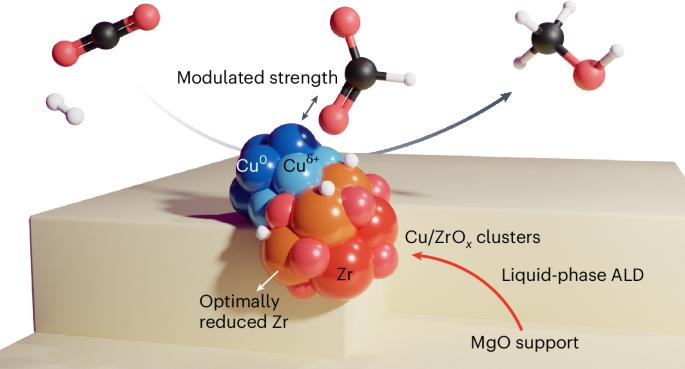利用液相原子层沉积技术在氧化镁上逐个原子设计用于二氧化碳加氢的铜/氧化锆团簇
IF 44.6
1区 化学
Q1 CHEMISTRY, PHYSICAL
引用次数: 0
摘要
由于难以合成原子精度一致的活性位点,限制了我们设计活性越来越高的异质催化剂将二氧化碳氢化为甲醇的能力。在这里,我们采用液相原子层沉积方法,在氧化镁上设计了接近原子精度的铜/氧化锆团簇,用于二氧化碳加氢。可控的团簇结构调节了 CO2 的结合强度,并适度稳定了单齿形式--甲醇生产的重要反应中间体。在 200 ℃ 和 250 ℃ 条件下,我们分别获得了 100% 和 76.7% 的甲醇选择性,甲醇生产率比通过浸渍法制备的相同催化剂高出一到两个数量级。Ab initio 计算表明,Cu/ZrOx 团簇可以调节 Zr 的氧化,从而控制催化剂上反应中间产物的稳定性。我们的方法证明了对催化剂团簇进行精确原子控制以提高催化生产率的潜力。本文章由计算机程序翻译,如有差异,请以英文原文为准。


Atom-by-atom design of Cu/ZrOx clusters on MgO for CO2 hydrogenation using liquid-phase atomic layer deposition
The difficulty of synthesizing uniform atomically precise active sites limits our ability to engineer increasingly more active heterogeneous catalysts for the hydrogenation of CO2 to methanol. Here we design Cu/ZrOx clusters on MgO with near atomic precision for CO2 hydrogenation using a liquid-phase atomic layer deposition method. The controlled cluster structure modulates the binding strength of CO2 and moderately stabilizes monodentate formate—an essential reaction intermediate for methanol production. We achieved a methanol selectivity of 100 and 76.7% at 200 and 250 °C, respectively and a methanol productivity that was one to two orders of magnitude higher than when the same catalysts were prepared by impregnation. Ab initio computations show that Cu/ZrOx clusters can tune the oxidation of Zr, which controls the stability of reaction intermediates on the catalyst. Our approach demonstrates the potential of precise atomic control of catalytic clusters to improve catalytic productivity. Achieving atomic control during the synthesis of heterogeneous catalysts remains challenging. Here the authors tackle this challenge by applying a liquid-phase atomic layer deposition approach to the synthesis of Cu/ZrOx clusters on MgO as efficient catalysts for CO2 hydrogenation to methanol.
求助全文
通过发布文献求助,成功后即可免费获取论文全文。
去求助
来源期刊

Nature Catalysis
Chemical Engineering-Bioengineering
CiteScore
52.10
自引率
1.10%
发文量
140
期刊介绍:
Nature Catalysis serves as a platform for researchers across chemistry and related fields, focusing on homogeneous catalysis, heterogeneous catalysis, and biocatalysts, encompassing both fundamental and applied studies. With a particular emphasis on advancing sustainable industries and processes, the journal provides comprehensive coverage of catalysis research, appealing to scientists, engineers, and researchers in academia and industry.
Maintaining the high standards of the Nature brand, Nature Catalysis boasts a dedicated team of professional editors, rigorous peer-review processes, and swift publication times, ensuring editorial independence and quality. The journal publishes work spanning heterogeneous catalysis, homogeneous catalysis, and biocatalysis, covering areas such as catalytic synthesis, mechanisms, characterization, computational studies, nanoparticle catalysis, electrocatalysis, photocatalysis, environmental catalysis, asymmetric catalysis, and various forms of organocatalysis.
 求助内容:
求助内容: 应助结果提醒方式:
应助结果提醒方式:


